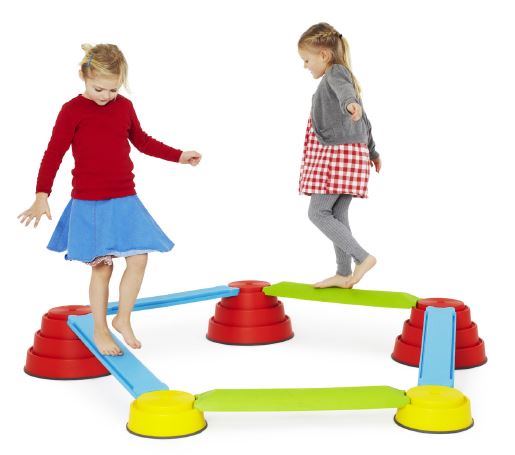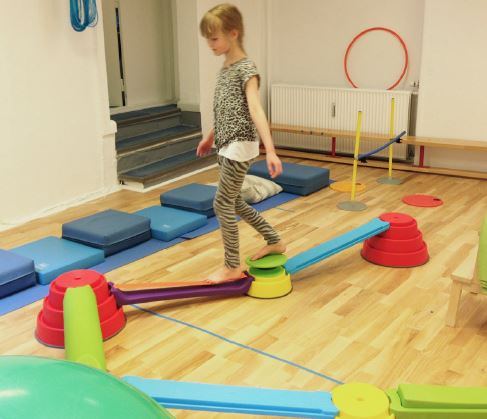Build N’ Balance en training van dynamische balans en het evenwichtsorgaan (vestibulair systeem) bij hoogsensitieve kinderen
Het thema van dit artikel, geschreven door fysiotherapeut Hannah Harboe, is training van het vestibulair systeem en dynamische balans bij hoogsensitieve kinderen met behulp van de Build N’ Balance loopbaan.
Een deel van de populatie is hoog sensitief. Hypersensitiviteit in het zintuiglijk apparaat kan significant zijn bij het leren van motorische vaardigheden en de bereidheid van een kind om te bewegen. Het kind vindt het moeilijk om inkomende zintuiglijke indrukken te scheiden en heeft de neiging om daar overdreven op te reageren.
Als het vestibulair systeem te sterk reageert dan heeft het kind het gevoel dat hij/zij de controle verliest en is bang om te vallen, zelfs bij hele eenvoudige balans uitdagingen. Corrigerende bewegingen om de balans te bewaren worden vaak overdreven, het kind is vaak bang en zijn/haar bewegingen bij spelen en motorische activiteit zijn vaak erg voorzichtig.
Een hoogsensitief kind voelt, hoort, proeft en reageert veel heftiger en intensiever.

Om zeker te stellen dat de hersenen een beweging leert herkennen en automatiseert moet een beweging vaak herhaald worden. Een geautomatiseerde respons is efficiënter, economischer en minder veeleisend en de beweging zelf is van een betere kwaliteit.
Vestibulaire stimulatie is elk type stimulatie dat het lichaam aanzet tot een reactie op een beweging, versnelling of verandering van richting om de balans te kunnen bewaren.
Case:
Anne is a seven-year-old girl. She is socially polite and pleasant. She enjoys interacting with adults and play dates with one friend at a time.
However, she withdraws and finds it difficult to participate in play in a large group. At school she is insecure and gets upset before a PE lesson. She says PE is smelly and there is too much noise. She always manages to stand at the back with all her classmates in front of her. She makes sure that she is not surprised when the other children start running and that she can see them before they get too close to her.
There are many activities that Anne neither can nor will take part in. She dare not climb wall bars or slide down a slide. She cannot cycle, scoot or roller-skate.
Anne comes to me for training. We talk about my helping her so that her body no longer gives her as many shocks. The training is intended to give her self-confidence and willingness to take part in and have fun with sports and physical activities at school.
When she trains with me, she does not have to compare herself with other children. She compares only what she dared to try and could do last time she was here and becomes aware that practice and repetition is what she needs to become more proficient and more courageous.
Anne is afraid of being raised from the floor so we start by building a Build N’ Balance® trail of yellow tops and blue balancing planks. Anne must take three steps on each plank. Three steps ensure that she walks carefully and is aware that she has to place her feet close to each other. When she focuses on her feet, her sense of sight helps her to keep her balance, and minimises her tendency to flail with her arms when she thinks she is losing her balance.
If she does lose her balance, she is so close to the floor that she is able to regain balance by putting one foot on the floor.
When she has successfully completed the trail three times without losing her balance, we replace the yellow tops with red tops and raise the plank successively to the second and third ridge. Then we make the trail more difficult. We position the planks at an angle and use the more demanding green and purple planks. Finally, we make the trail as difficult as possible and Anne helps to figure out how to position the planks to make the trail more challenging.
After each trail, I praise Anne for her bravery. She has to feel that she can manage and has control over the activity before we make it more difficult.
When she comes to the next training session, Anne has thought out how she will put elements together to create a difficult trail. She experiments and tries out the trail to see how well she can do it. Anne beams with pleasure and seems more self-assured and confident. The high point is when she tells me that now that, she can walk on a narrow plank at training without falling off it, she thinks that she can stand on a scooter without falling.
We agree that she will try to learn to scoot with her Dad at the weekend.
Copyright: © Gonge Creative Learning ApS 2015

